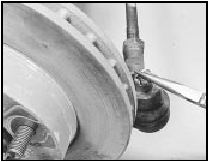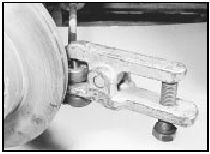Tie-rod end - removal and refitting
Note: A balljoint separator tool will be required for this operation.
Removal
1 Loosen the relevant front roadwheel nuts,
apply the handbrake, jack up the front of the
vehicle and support on axle stands.
2 Remove the roadwheel. On P100 models mark the position of the roadwheel in relation to one of the wheel studs before removal.
3 Make alignment marks on the tie-rod and tie-rod end, then loosen the locknut by a quarter of a turn.
4 Extract the split pin and unscrew the castellated nut (see illustration).

33.4 Extracting the split pin from the tierod balljoint castellated nut
5 Using a balljoint separator tool, release the tie-rod end from the hub carrier (see illustration).

33.5 Using a balljoint separator tool to release the tie-rod end from the hub
carrier
6 Unscrew the tie-rod end from the tie-rod, noting the number of turns necessary to remove it.
Refitting
7 Refitting is a reversal of removal, bearing in
mind the following points.
8 Screw the tie-rod end onto the tie-rod the number of turns noted during removal.
9 Tighten the nuts to the specified torque, and fit a new split pin to the castellated nut.
10 On P100 models, align the previously made marks on the roadwheel and wheel stud.
11 On completion, check and if necessary adjust the front wheel alignment.
See also:
AM/FM stereo/cassette
Volume/power control
Press the control to turn the audio
system on or off.
Turn control to raise or lower
volume.
If the volume is set above a certain level and the ignition is turned off,
...
Charge air temperature sensor - removal and refitting
Removal
1 The charge air temperature sensor is only
used on KE-Jetronic systems and is located in
the air inlet duct (see illustration).
17.1 Charge air temperature sensor location (arrowed)
2 ...
Cylinder head and pistons - decarbonising
1 With the cylinder head removed as
described in Section 7, the carbon deposits
should be removed from the combustion
surfaces using a blunt scraper. Take great
care as the head is of light alloy ...
